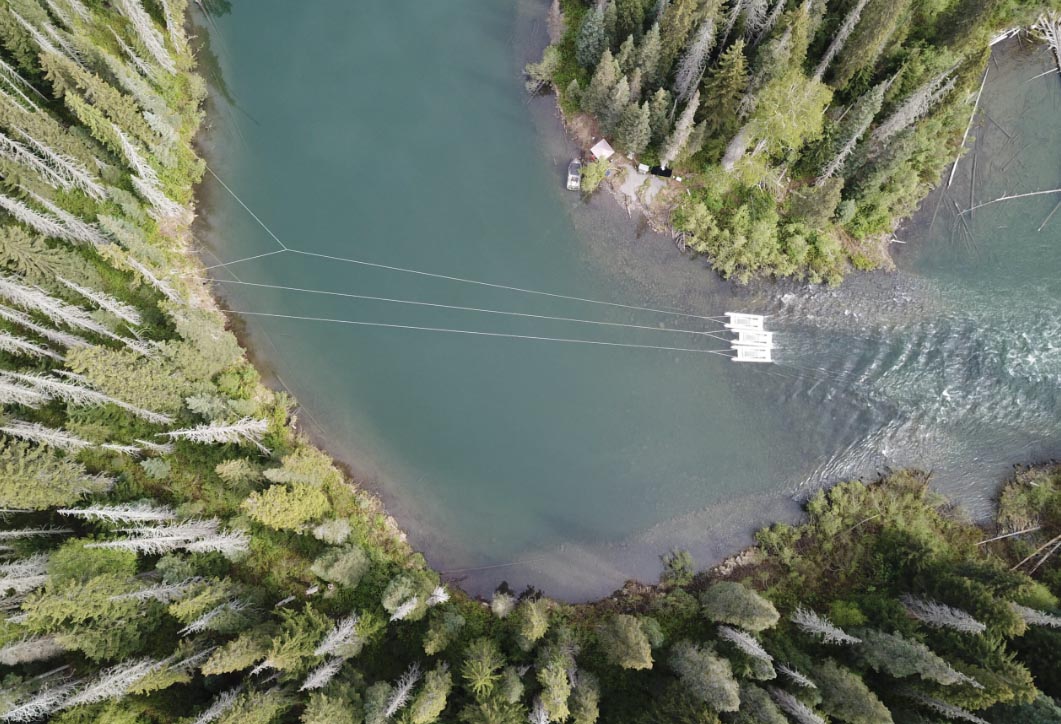Gitanyow Fisheries Authority and Skeena Fisheries Commission Deploy Custom BioSonics Scientific Sonar System
In May 2024, a BioSonics scientific sonar system was deployed in the Meziadin River, British Columbia, for Gitanyow Fisheries Authority in collaboration with the Skeena Fisheries Commission. Representing a significant advancement in fisheries management this innovative technology aims to enhance the monitoring of out-migrating sockeye smolt, essential for conserving native salmon populations, upholding traditional fishing rights, blending traditional practices with modern technology, and providing valuable data for fisheries management.
The project was spearheaded by the Gitanyow Fisheries Authority, operating under the guidance of Gitanyow Hereditary Chiefs, with significant support from the Skeena Fisheries Commission, which represents the Gitxsan, Gitanyow, and Wet’suwet’en Nations.
Janvier Doire, fisheries biologist with the Skeena Fisheries Commission, led the project and coordinated closely with the BioSonics team to implement this cutting-edge solution.
“Accurate monitoring is key to managing fish stocks and maintaining the ecological balance of the Meziadin River,” said Janvier. “The custom up-looking hydroacoustic system developed and assembled by BioSonics to estimate the out-migrating sockeye smolt in the Meziadin River proved to be extremely robust and operated flawlessly over the seven weeks of continuous operation in a very challenging environment.”
Deploying in Remote British Columbia
The project site is located in a very remote area of the Meziadin River, accessible only by boat. This necessitates a specialized solar power/communications system to ensure continuous operation.
The BioSonics system is comprised of five sonar pods and was designed specifically for this project. Four of the sonar pods are complete 200 kHz single beam transducer/echosounder sequentially cabled. The fifth sonar pod is a 200 kHz split beam transducer connected to a DT-X Extreme echosounder which is used to estimate the average smolt target strength.
The sonar pods are strategically mounted on the riverbed and connected to a base station housed in a weather-resistant enclosure. The site employs Starlink Internet for remote monitoring and continuous data transmission, which is crucial for ensuring proper operation of the system over several weeks. Automated features include remote reporting, system control, and power management, resulting in a system that provides precise data on fish size, abundance and migration patterns – information crucial for understanding population dynamics and supporting sustainable fisheries management.
BioSonics partnered with the full project team to provide technical support at every step of the project. “The support from BioSonics was outstanding, with software and electrical engineers available via phone or video at any time” said Janvier.
How the Meziadin System Works
The system of five sonar pods transmits synchronized upward pings to eliminate crosstalk and enhance data accuracy. Each pod is equipped with integrated pitch and roll sensors to ensure stable data collection. Data captured by these pods is transmitted sequentially to a shoreside base station, where it is processed and stored on an external drive.
The system logs acoustic data to estimate fish passage, capturing reflections from smolt schools and individual smolt as they move through the sonar beams. This data includes horizontal, vertical, and temporal distributions of the fish, providing comprehensive insights into fish behaviour and population dynamics. BioSonics Visual Acquisition software allows users to configure sonar parameters, log data continuously, and perform post-processing to produce accurate estimates of fish passage, supporting effective fisheries management.
The custom Meziadin system successfully ran for the full project time of seven weeks, continuously transmitting invaluable smolt data.
“We have a great relationship with Janvier Diore, and have valued working with him over the years,” said Tim Acker, President of BioSonics. “His knowledge, careful planning, and passion for advancing the management of this culturally and economically important salmon fishery, made this project a huge success! We were delighted to be part of this positive and forward-looking team – together bringing the most modern hydroacoustic methods and digital insights to fish passage monitoring.”
For more information, visit Skeena Fisheries Commission and Gitanyow Fisheries Authority.
Read the original article on BioSonics website.
